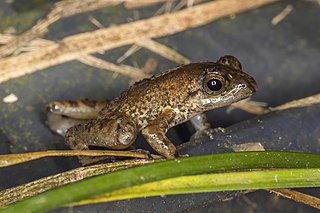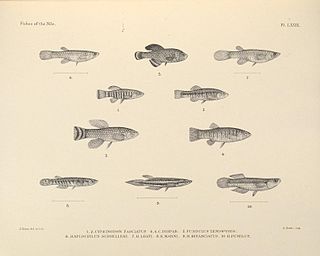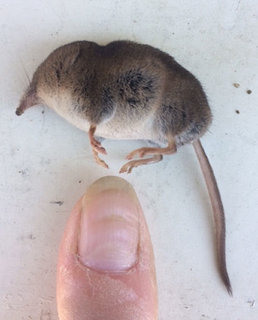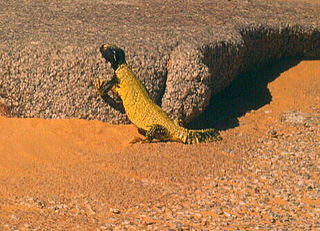Related Research Articles

Lymantria dispar, sometimes known as the gypsy moth, or now spongy moth, is a species of moth in the Erebidae family. Lymantria dispar is subdivided into several subspecies, with subspecies such as L. d. dispar and L. d. japonica being clearly identifiable without ambiguity. Lymantria dispar has been introduced to several continents and is now found in Europe, Africa, Asia, North America and South America. The polyphagous larvae live on a variety of deciduous and coniferous trees and can cause severe damage in years of mass reproduction. Due to these features, Lymantria dispar is listed among the world's 100 most invasive alien species.

Uromastyx is a genus of African and Asian agamid lizards, the member species of which are commonly called spiny-tailed lizards, uromastyces, mastigures, or dabb lizards. Lizards in the genus Uromastyx are primarily herbivorous, but occasionally eat insects and other small animals, especially young lizards. They spend most of their waking hours basking in the sun, hiding in underground chambers at daytime, or when danger appears. They tend to establish themselves in hilly, rocky areas with good shelter and accessible vegetation.

The genus Sorex includes many of the common shrews of Eurasia and North America, and contains at least 142 known species and subspecies. Members of this genus, known as long-tailed shrews, are the only members of the tribe Soricini of the subfamily Soricinae. They have 32 teeth.

Ichthyornis is an extinct genus of toothed seabird-like ornithuran from the late Cretaceous period of North America. Its fossil remains are known from the chalks of Alberta, Alabama, Kansas, New Mexico, Saskatchewan, and Texas, in strata that were laid down in the Western Interior Seaway during the Turonian through Campanian ages, about 95–83.5 million years ago. Ichthyornis is a common component of the Niobrara Formation fauna, and numerous specimens have been found.

Cherax, commonly known as yabby/yabbies in Australia, is the most widespread genus of fully aquatic crayfish in the Southern Hemisphere. Various species of cherax may be found in both still and flowing bodies of freshwater across most of Australia and New Guinea. Together with Euastacus, it is also the largest crayfish genus in the Southern Hemisphere.

The large copper is a butterfly of the family Lycaenidae. L. dispar has been commonly arranged into three subspecies: L. dispar dispar, (single-brooded) which was commonly found in England, but is now extinct, L. d. batavus, (single-brooded) can be found in the Netherlands and has been reintroduced into the United Kingdom, and lastly, L. d. rutilus, (double-brooded) which is widespread across central and southern Europe. The latter has been declining in many European countries, due to habitat loss. Currently L. dispar is in severe decline in northwest Europe, but expanding in central and northern Europe.

Camptosaurus is a genus of plant-eating, beaked ornithischian dinosaurs of the Late Jurassic period of western North America and possibly also Europe. The name means 'flexible lizard'.

Ichthyornithes is an extinct group of toothed avialans very closely related to the common ancestor of all modern birds. They are known from fossil remains found throughout the late Cretaceous period of North America, though only one species, Ichthyornis dispar, is represented by complete enough fossils to have been named. Ichthyornitheans became extinct at the Cretaceous–Paleogene boundary, along with enantiornitheans, all other non-avian dinosaurs, and many other animal and plant groups.

Phyllobius is a genus of weevils containing at least 60 described species, some of which are commonly found in Europe.

Phrynobatrachus dispar is a species of frog in the family Phrynobatrachidae. It is known as Peters' River Frog and the Príncipe puddle frog. It is endemic to São Tomé and Príncipe. Its natural habitat is puddles in primary forest, farm bush, and abandoned plantations. It was first described as Arthroleptis dispar by Wilhelm Peters in 1870. They are found on the island of Príncipe in areas up to 947 meters above sea level.
The Kai cicadabird is a species of bird in the family Campephagidae. It is endemic to Indonesia.
Halimornis was an enantiornithine bird. It lived during the Late Cretaceous about 80 mya and is known from fossils found in the Mooreville Chalk Formation in Greene County, Alabama. It is known from a single fossil individual, including preserved vertebrae, leg bones and part of the humerus.

Amoebiasis, or amoebic dysentery, is an infection caused by Entamoebahistolytica. Amoebiasis can be present with no, mild, or severe symptoms. Symptoms may include lethargy, loss of weight, colonic ulcerations, abdominal pain, diarrhea, or bloody diarrhea. Complications can include inflammation and ulceration of the colon with tissue death or perforation, which may result in peritonitis. People affected may develop anemia due to prolonged gastric bleeding

Dispar compacta, the dispar skipper or barred skipper, is a butterfly of the family Hesperiidae. It is found in the Australian Capital Territory, New South Wales, Queensland, South Australia and Victoria.

Lymantria dispar dispar, commonly known as the gypsy moth, European gypsy moth, or North American gypsy moth, is a species of moth in the family Erebidae that is of Eurasian origin. It has a range that extends over Europe, Africa, and North America.

The Arabian toothcarp, known also as the Arabian pupfish or mother-of-Pearl fish is a species of killifish belonging to the family Cyprinodontidae. It can be found from the shores of the Red Sea south to Ethiopia, the Gulf of Aden, the Arabian Sea and along the Persian Gulf east to Pakistan and India. It is also found in the Suez Canal, the northern coast of the Sinai Peninsula, and in one location on the palestine coast. There are two recognized subspecies: A. d. dispar found throughout the range, and A. d. richardsoni, the Dead Sea toothcarp endemic to the Dead Sea.

The long-tailed shrew or rock shrew is a small North American shrew found in Atlantic Canada and the Northeastern United States.
The fleshysnout catfish is a species of sea catfish in the family Ariidae. It was described by Albert William Herre in 1926, originally under the genus Tachysurus. It is known from tropical brackish and freshwater in Asia, including the Philippines, Taiwan, and possibly Borneo. It reaches a maximum standard length of 34 cm (13 in).
Pararhytiphora nigropunctata is a species of beetle in the family Cerambycidae. It was described by Stephan von Breuning in 1938.

Uromastyx dispar, the Sudan mastigure, is a species of agamid lizard. It is found in Mauritania, Sudan, Chad, Western Sahara, Algeria, and Mali.
References
- ↑ BioLib.cz - Pararhytiphora dispar. Retrieved on 8 September 2014.